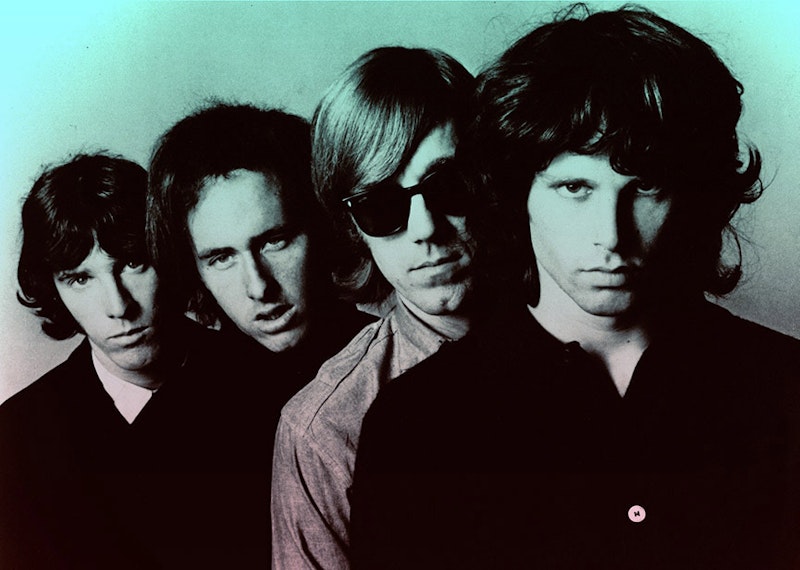More than a half a century ago, teenagers from nearby towns and cities descended upon New York City on January 17–18, 1970. During a time of tumultuous cultural and social changes in America, they huddled together trying to keep warm along the sidewalks of 8th Ave. The crowds waited to see The Doors play four shows at the Felt Forum. The intimate concert setting: a crescent-shaped theater with a low 20-foot ceiling at stage level was tucked beneath Madison Square Garden. It’d be the group’s final performances in New York.
Cars pulled up to the curb to make drop-offs. Embarrassed kids underneath the Felt Forum canopy headed towards the lobby doors because they forced their parents to drive. Thumbing rides in from Long Island, a few hitchhikers met new acquaintances. A hippie runaway with a hand-rolled cigarette took one last drag. The vast drug consuming capacity of the crowd transformed their shared energy into an aura of anticipation. Long-haired youths drawn to the darker side of rock music had found their freedom, man. He’s got some friends inside.
No one has The Doors’ distinctive sound. Their creative efforts lasted a relatively short period of time, only 57 months. A complex young man, a non-conformist who sang about love, bleak discord and revolution in America, led the band.
Jim Morrison became a wanted man and kept a relatively low profile after a March 1969 Miami performance. Keyboardist Ray Manzarek, the band’s glue said, “He’s going to show these Florida people what psychedelic West Coast shamanism and confrontation is all about.” It was another brush with the law for the “send my credentials to the house of detention” native Floridian. Morrison was yet to serve a Dade County six-month sentence for lewd public behavior and profanity. After the incident, The Doors were blacklisted and temporally banned from touring.
Morrison retreated back to Los Angeles driving the wrong way down alleyways. The only car Mr. Mojo Risin’ (an anagram for Jim Morrison) ever owned was called The Blue Lady. The vehicle was a 1967 Nightmist Blue GT500 Shelby Mustang. With Jim behind the wheel in a lawless fashion, feeling power to the core—the 0 to 60 in 6.5 seconds muscle machine tore through the stark loneliness of the Mojave landscape. Seeking a sense of connection with the unique desert beauty of California, he worked on an unfinished film project with friends: HWY: An American Pastoral.
Jac Holzman, the head of Elektra Records, gave Morrison the car as a thank-you for the success of their number-one hit song “Light My Fire.” Naturally, Jim desired top-tier horsepower after seeing his hairstylist Jay Sebring’s GT350. If Sebring sounds familiar; he was murdered along with Sharon Tate and others by the Manson Family. Despite the rumors, no one knows for sure what happened to the original Shelby to this day.
Several tracks on the Absolutely Live album were recorded from the shows. Morrison would’ve been pumped for the performances. It was hot inside the Felt, the crowd was packed tight with an estimated 5000 or so people in attendance. Morrison had a history of inciting crowds. Towards the end of the last show, he summoned the masses; a wave of bodies moved across the floor when they heard “Everybody come on up.”
Besieged by an army of fans, the crowd rushed the stage. People elbowed their way forward. No one gave an inch navigating a path to listen to a 26-year-old lead singer’s husky bold voice interspersed between powerful deep screams. The press reported dozens of young fans had to be pulled off stage. Humanity reached out to touch, others kissed, and some received a never-to-be-forgotten handshake.
The Doors recorded their final album in a West Hollywood studio known as “The Doors Workshop” during the winter of 1970–1971. The sessions fulfilled Morrison’s Elektra contract. An Australian music program GTK shot “Crawling King Snake” performed in rehearsal, one of their last times together.
In March 1971, Morrison left Los Angeles and headed to France with companion Pamela Courson. Fellow band members Manzarek, Robby Krieger, and John Densmore finished the final mixes. On April 19, 1971, LA Woman was released, coincidentally the same day Manson was sentenced to life in prison. Weeks later on July 3, 1971; the same day the Stones’ Brian Jones was discovered at the bottom of his swimming pool in 1969; Jim Morrison was found in a Paris bathtub.
Rock music doesn’t chart or sell as well as it once did. The Doors’ songs remind us of how quickly time flies, a lost love or a stormy night. Rejuvenating experiences, like listening to timeless music inspire those who remember and those who don’t. We frequently filter out the painful and negative in nostalgia. It’s a way to improve wellbeing by reforming history or glorifying myth to fit our own persona. For serious fans and historians who want to go digging inside the goldmine, there’s MildEquator.com the definitive Doors online resource.
Whether Jim Morrison would’ve survived his shortcomings, no one will ever know. It’s hard having staying power in the music industry—a gift for a select few, say Paul McCartney—one can only speculate. And touring in your elder years? Look at what happened to Tom Petty. Ultimately, fading memories learn to forget.

